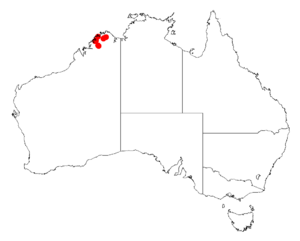Sandstone pavement wattle facts for kids
Quick facts for kids Sandstone pavement wattle |
|
|---|---|
| Conservation status | |
| Scientific classification | |
| Genus: |
Acacia
|
| Species: |
diastemata
|
 |
|
| Occurrence data from AVH | |
The Acacia diastemata, often called the sandstone pavement wattle, is a type of shrub or small tree. It's part of the Acacia family. This plant only grows naturally in a small part of north-western Australia. When a plant or animal is found only in one specific area, it's called endemic.
Contents
What the Sandstone Pavement Wattle Looks Like
This shrub or small tree usually grows to be about 2 to 5 meters tall. It has a loose, upright shape. Its bark is grey and feels like it has fibers.
Leaves and Stems
The young stems are brown and have fine ribs. As they get older, they turn grey. Like most Acacia plants, it doesn't have regular leaves. Instead, it has phyllodes. These are flattened leaf stems that act like leaves.
The phyllodes are thin and can bend easily. They stay green all year. They are long and narrow, usually 9 to 16 centimeters long and 1 to 2 millimeters wide. They end in a blunt tip. These phyllodes are smooth, meaning they have no hairs. They can be straight or slightly curved. Each phyllode has three main lines, or nerves, running along its length.
Flowers
The sandstone pavement wattle produces bright yellow flowers. It blooms during the months of March, April, May, and June.
Where the Sandstone Pavement Wattle Grows
This wattle plant is found only in the eastern Kimberley region of Western Australia. It grows in many places there, but usually in small, separate groups. You can find it from the Prince Regent River in the southwest to the Roe River in the north. It also grows as far east as the Drysdale River National Park.
Habitat and Environment
The plant spreads across an area of about 200 kilometers. It often grows among rocks on ridges. These ridges are made of quartzite or sandstone. It also likes large, flat areas of sandstone.
The sandstone pavement wattle often grows in scrubland communities. These are areas with many shrubs and small trees. Other plants found with it include Acacia kenneallyi, Hibiscus superbus, Macarthuria vertex, and different types of Triodia and Triumfetta.


